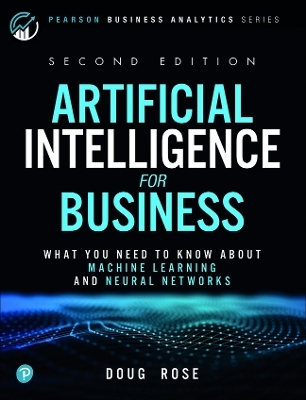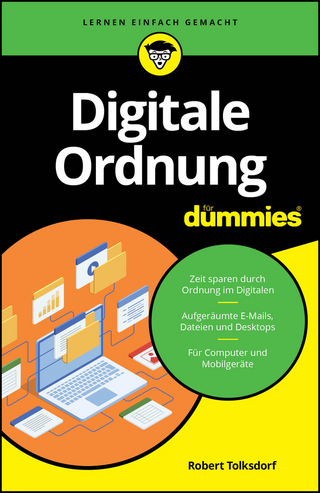
Artificial Intelligence for Business
Pearson (Verlag)
978-0-13-655661-9 (ISBN)
Artificial Intelligence for Business is your plain-English guide to Artificial Intelligence (AI) and Machine Learning (ML): how they work, what they can and cannot do, and how to start profiting from them. Writing for nontechnical executives and professionals, Doug Rose demystifies AI/ML technology with intuitive analogies and explanations honed through years of teaching and consulting. Rose explains everything from early “expert systems” to advanced deep learning networks.
First, Rose explains how AI and ML emerged, exploring pivotal early ideas that continue to influence the field. Next, he deepens your understanding of key ML concepts, showing how machines can create strategies and learn from mistakes. Then, Rose introduces current powerful neural networks: systems inspired by the structure and function of the human brain. He concludes by introducing leading AI applications, from automated customer interactions to event prediction. Throughout, Rose stays focused on business: applying these technologies to leverage new opportunities and solve real problems.
Compare the ways a machine can learn, and explore current leading ML algorithms
Start with the right problems, and avoid common AI/ML project mistakes
Use neural networks to automate decision-making and identify unexpected patterns
Help neural networks learn more quickly and effectively
Harness AI chatbots, virtual assistants, virtual agents, and conversational AI applications
Doug Rose has been transforming organizations through technology, training, and process optimization for more than 25 years. He is the author of the Project Management Institute (PMI) first major publication on the agile framework, Leading Agile Teams. He is also the author of Data Science: Create Teams That Ask the Right Questions and Deliver Real Value and Enterprise Agility for Dummies. Doug has a master degree (MS) in information management, a law degree (JD) from Syracuse University, and a BA from the University of Wisconsin-Madison. He is also a Scaled Agile Framework Program Consultant (SPC), Certified Technical Trainer (CTT+), Certified Scrum Professional (CSP-SM), Certified Scrum Master (CSM), PMI Agile Certified Professional (PMI-ACP), Project Management Professional (PMP), and Certified Developer for Apache Hadoop (CCDH). You can attend his lively and engaging business and project management courses at the University of Chicago or online through LinkedIn Learning. Doug works through Doug Enterprises, an organization with an office in whatever city he lives. Currently he lives in Atlanta, Georgia, where he spends his free time either riding a stationary recumbent bike or explaining the Marvel Universe to his son.
Foreword xv
Preface xix
PART I: Thinking Machines: An Overview of Artificial Intelligence 1
Chapter 1: What Is Artificial Intelligence? 3
What Is Intelligence? 4
Testing Machine Intelligence 6
The General Problem Solver 8
Strong and Weak Artificial Intelligence 11
Artificial Intelligence Planning 14
Learning over Memorizing 15
Chapter Takeaways 18
Chapter 2: The Rise of Machine Learning 19
Practical Applications of Machine Learning 22
Artificial Neural Networks 24
The Fall and Rise of the Perceptron 27
Big Data Arrives 30
Chapter Takeaways 33
Chapter 3: Zeroing in on the Best Approach 35
Expert System Versus Machine Learning 35
Supervised Versus Unsupervised Learning 37
Backpropagation of Errors 38
Regression Analysis 41
Chapter Takeaways 43
Chapter 4: Common AI Applications 45
Intelligent Robots 45
Natural Language Processing 48
The Internet of Things 50
Chapter Takeaways 51
Chapter 5: Putting AI to Work on Big Data 53
Understanding the Concept of Big Data 54
Teaming Up with a Data Scientist 54
Machine Learning and Data Mining: What's the Difference? 55
Making the Leap from Data Mining to Machine Learning 56
Taking the Right Approach 57
Chapter Takeaways 59
Chapter 6: Weighing Your Options 61
Chapter Takeaways 64
PART II: Machine Learning 65
Chapter 7: What Is Machine Learning? 67
How a Machine Learns 71
Working with Data 74
Applying Machine Learning 77
Different Types of Learning 79
Chapter Takeaways 81
Chapter 8: Different Ways a Machine Learns 83
Supervised Machine Learning 83
Unsupervised Machine Learning 86
Semi-Supervised Machine Learning 89
Reinforcement Learning 91
Chapter Takeaways 93
Chapter 9: Popular Machine Learning Algorithms 95
Decision Trees 99
k-Nearest Neighbor 101
k-Means Clustering 104
Regression Analysis 108
Naive Bayes 110
Chapter Takeaways 113
Chapter 10: Applying Machine Learning Algorithms 115
Fitting the Model to Your Data 119
Choosing Algorithms 120
Ensemble Modeling 121
Deciding on a Machine Learning Approach 123
Chapter Takeaways 124
Chapter 11: Words of Advice 125
Start Asking Questions 125
Don't Mix Training Data with Test Data 127
Don't Overstate a Model's Accuracy 127
Know Your Algorithms 128
Chapter Takeaways 128
PART III: Artificial Neural Networks 129
Chapter 12: What Are Artificial Neural Networks? 131
Why the Brain Analogy? 133
Just Another Amazing Algorithm 133
Getting to Know the Perceptron 135
Squeezing Down a Sigmoid Neuron 138
Adding Bias 141
Chapter Takeaways 142
Chapter 13: Artificial Neural Networks in Action 143
Feeding Data into the Network 143
What Goes on in the Hidden Layers 145
Understanding Activation Functions 149
Adding Weights 151
Adding Bias 152
Chapter Takeaways 153
Chapter 14: Letting Your Network Learn 155
Starting with Random Weights and Biases 156
Making Your Network Pay for Its Mistakes: The Cost Function 157
Combining the Cost Function with Gradient Descent 158
Using Backpropagation to Correct for Errors 160
Tuning Your Network 163
Employing the Chain Rule 164
Batching the Data Set with Stochastic Gradient Descent 166
Chapter Takeaways 167
Chapter 15: Using Neural Networks to Classify or Cluster 169
Solving Classification Problems 170
Solving Clustering Problems 172
Chapter Takeaways 174
Chapter 16: Key Challenges 175
Obtaining Enough Quality Data 175
Keeping Training and Test Data Separate 176
Carefully Choosing Your Training Data 177
Taking an Exploratory Approach 177
Choosing the Right Tool for the Job 178
Chapter Takeaways 178
PART IV: Putting Artificial Intelligence to Work 179
Chapter 17: Harnessing the Power of Natural Language Processing 181
Extracting Meaning from Text and Speech with NLU 183
Delivering Sensible Responses with NLG 184
Automating Customer Service 186
Reviewing the Top NLP Tools and Resources 187
NLU Tools 189
NLG Tools 190
Chapter Takeaways 191
Chapter 18: Automating Customer Interactions 193
Choosing Natural Language Technologies 195
Review the Top Tools for Creating Chatbots and Virtual Agents 196
Chapter Takeaways 198
Chapter 19: Improving Data-Based Decision-Making 199
Choosing Between Automated and Intuitive Decision-Making 201
Gathering Data in Real Time from IoT Devices 202
Reviewing Automated Decision-Making Tools 204
Chapter Takeaways 205
Chapter 20: Using Machine Learning to Predict Events and Outcomes 207
Machine Learning Is Really about Labeling Data 208
Looking at What Machine Learning Can Do 210
Predict What Customers Will Buy 210
Answer Questions Before They're Asked 210
Make Better Decisions Faster 212
Replicate Expertise in Your Business 213
Use Your Power for Good, Not Evil: Machine Learning Ethics 214
Review the Top Machine Learning Tools 216
Chapter Takeaways 218
Chapter 21: Building Artificial Minds 219
Separating Intelligence from Automation 221
Adding Layers for Deep Learning 222
Considering Applications for Artificial Neural Networks 223
Classifying Your Best Customers 224
Recommending Store Layouts 225
Analyzing and Tracking Biometrics 226
Reviewing the Top Deep Learning Tools 228
Chapter Takeaways 229
Index 231
| Erscheinungsdatum | 31.12.2019 |
|---|---|
| Reihe/Serie | Pearson Business Analytics Series |
| Sprache | englisch |
| Maße | 178 x 229 mm |
| Gewicht | 440 g |
| Themenwelt | Informatik ► Office Programme ► Outlook |
| Informatik ► Theorie / Studium ► Künstliche Intelligenz / Robotik | |
| Mathematik / Informatik ► Mathematik ► Finanz- / Wirtschaftsmathematik | |
| ISBN-10 | 0-13-655661-2 / 0136556612 |
| ISBN-13 | 978-0-13-655661-9 / 9780136556619 |
| Zustand | Neuware |
| Informationen gemäß Produktsicherheitsverordnung (GPSR) | |
| Haben Sie eine Frage zum Produkt? |
aus dem Bereich


